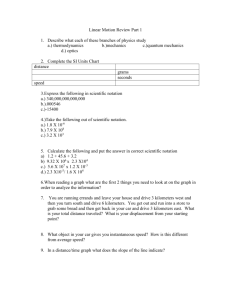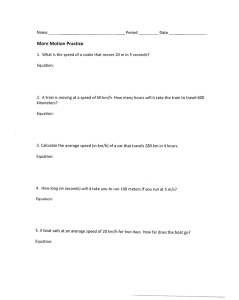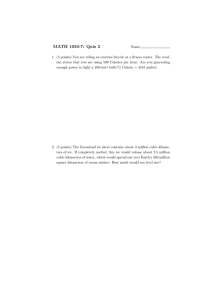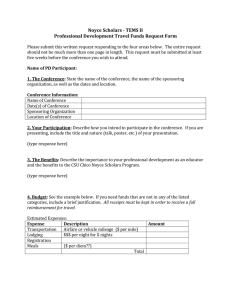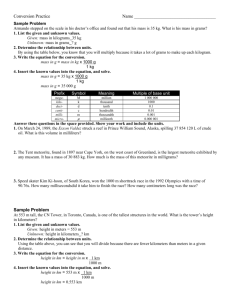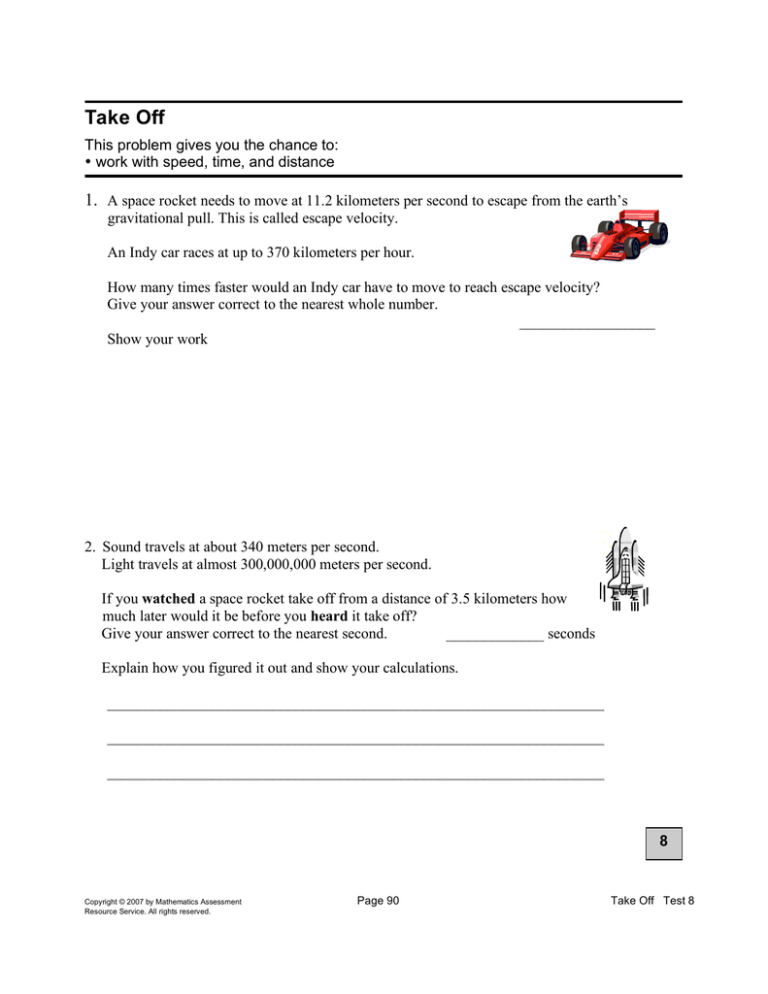
Take Off
This problem gives you the chance to:
• work with speed, time, and distance
1. A space rocket needs to move at 11.2 kilometers per second to escape from the earth’s
gravitational pull. This is called escape velocity.
An Indy car races at up to 370 kilometers per hour.
How many times faster would an Indy car have to move to reach escape velocity?
Give your answer correct to the nearest whole number.
__________________
Show your work
2. Sound travels at about 340 meters per second.
Light travels at almost 300,000,000 meters per second.
If you watched a space rocket take off from a distance of 3.5 kilometers how
much later would it be before you heard it take off?
Give your answer correct to the nearest second.
_____________ seconds
Explain how you figured it out and show your calculations.
__________________________________________________________________
__________________________________________________________________
__________________________________________________________________
8
Copyright © 2007 by Mathematics Assessment
Resource Service. All rights reserved.
Page 90
Take Off Test 8
Task 5: Take Off
Rubric
The core elements of performance required by this task are:
• work with speed, time and distance
points
section
points
Based on these, credit for specific aspects of performance should be assigned as follows
1.
Shows correct work such as:
11.2 x 60 x 60 =
40320 / 370
2.
1
Gives a correct answer: 109 (accept 112)
or 370 ÷ 60 ÷ 60 = 0.1027
11.2 ÷ 0.1027 =
Gives a correct answer: 10 seconds
3
2
Partial credit
Gives answer 10.29
(1)
Gives a correct explanation such as:
You would see the take off straight away.
3.5 kilometres = 3500 metres
3500 / 340
1
1
1
Total Points
Copyright © 2007 by Mathematics Assessment
Resource Service. All rights reserved.
1
1ft
Page 91
5
8
Take Off Test 8
Take Off
Work the task. What are the big mathematical ideas being assessed?
How often do students in your class work with converting between units of measure? What
are the classroom norms for using labels and dimensional analysis? Do you think students
have enough understanding of algebra to understand the effect multiplying or dividing by
measures with different units?
Did you see evidence that students understood that there were 3600 sec. in an hour? Did you
see evidence that students knew they needed to either change meters to kilometers or
kilometers to meters in part 2? How many of them showed evidence of knowing that a
kilometer is larger than a meter?
Look at student work in part 1.
• How many of the students could solve the problem correctly? How many of these
forgot to round their answers?
• How many made errors in the conversion, usually only multiplying or dividing by only
1 group of 60?
• How many of the students knew that this was a division situation? How many of the
students tried to multiply instead?
Look at student work in part 2.
• Did you see any evidence of thinking about the speed of light?
• How many students recognized that the units did not match and attempted to make
adjustments before dividing?
• How many students chose the wrong operation (subtraction, multiplication, addition)?
How does your textbook deal with the big mathematical idea of rate? Is it an extended topic
to develop understanding or an afterthought in word problems scattered throughout the text?
Is it taught as a generalization that can be applied to many situations or as a series of different
formulas for every different type of rate?
What would you like eighth graders to understand conceptually about rate?
How can you help students develop and use dimensional analysis on a regular basis to make
sense of their calculations?
th
8 grade – 2007
Copyright © 2007 by Noyce Foundation
Resource Service. All rights reserved.
92
Looking at Student Work on Taking Off
Student A Is able to use labels to make sense of the conversion of units in part 1 and then
compare the two rates. In part 2 the student converts the kilometers to meters and shows the
time = distance / rate, which is probably where the 10 sec comes from. While the student
doesn’t say that you will see it right away, the comparison subtraction shows some thinking
about the magnitude of difference between the two rates.
Student A
th
8 grade – 2007
Copyright © 2007 by Noyce Foundation
Resource Service. All rights reserved.
93
Student B makes the common error of only using one 60 when converting between per second
and per hour measures. The student seems to realize that comparisons by can be made by
subtraction and by division, and therefore does both. Notice that in part 2 the student is able to
explain clearly where the 10 seconds come from and that the speed of light is too fast to make
a difference.
Student B
th
8 grade – 2007
Copyright © 2007 by Noyce Foundation
Resource Service. All rights reserved.
94
Student C is able to do the conversions. He forgets to round in part 1 and makes a decimal
error in the division in part 2. The student does not consider the difference in speeds of the
light and sound.
Student C
th
8 grade – 2007
Copyright © 2007 by Noyce Foundation
Resource Service. All rights reserved.
95
Student D divides by two groups of 60; first getting 6.16 and then getting the 0.11 (which
should have been 1 pt.). This now converts the two rates to kilometers per second so that they
can be compared. The student chooses comparison subtraction, how much larger, instead of
comparison by division, how many times larger. The student doesn’t round in part 2 and does
not consider the speed of light.
Student D
th
8 grade – 2007
Copyright © 2007 by Noyce Foundation
Resource Service. All rights reserved.
96
Student E actually shows a correct strategy for finding the solution in part 1, which is not
recognized by the scorer. The student converts the kilometers per hour into kilometers per
second by diving by 60 twice. Now the rates can be compared. Multiplying by 109 is the
same as dividing the 11.2 by the 0.1027. The students thinking falls apart in part 2 where the
student divides the kilometers by 1000 instead of multiplying by 1000 to find the distance in
meters.
Student E
th
8 grade – 2007
Copyright © 2007 by Noyce Foundation
Resource Service. All rights reserved.
97
Student G actually shows thinking about the difference in the speed of light and the speed of
sound by writing out a subtraction equation. The student also has the correct number of
seconds but forgot to round. Rounding is a major issue for students. They want to have the
level of accuracy of their calculators, which does not match the accuracy of the instruments
used or the information needed by the problem. How do we help students think about this
matter and make sensible decisions about place value and significant digits?
Student G
Student H attempts to compare to ratios 340:3600 and 11.2:1. In order to make a comparison
between ratios one of the quantities needs to be fixed. Either the numerators need to be the
same so the denominators can be compared or the denominators need to be the same some the
numerators can be compared. This is a big mathematical generalization that students at this
grade level should be making. In part two the student multiplies the meters by 1000 instead of
dividing by 1000 to convert to kilometers. Do you think students in your class come to you
with the basic logic of making conversions? What do you do to help students develop an
understanding of conversions?
th
8 grade – 2007
Copyright © 2007 by Noyce Foundation
Resource Service. All rights reserved.
98
Student H
Student I does not notice the difference in units of the two rates in part 1. The student
attempts to make an absolute comparison in part 1 by subtracting, instead of comparison of
how many times larger, which would use division. How can we help students learn the
meaning of operations and understand the difference between the two types of comparison?
Notice again in part 2, the student does not pick up on the difference in units between meters
per second and kilometers.
th
8 grade – 2007
Copyright © 2007 by Noyce Foundation
Resource Service. All rights reserved.
99
Student I
th
8 grade – 2007
Copyright © 2007 by Noyce Foundation
Resource Service. All rights reserved.
100
Student J attempts to make a comparison, how many times larger in part 1. The failure to pay
attention to units makes the answer unsensible. So the student then just adds the two rates
making a decimal error in the process. In part 2 the student again ignores the difference in
units and chooses an incorrect operation for situation.
Student J
th
8 grade – 2007
Copyright © 2007 by Noyce Foundation
Resource Service. All rights reserved.
101
8th Grade
Task 5
Take Off
Student Task
Work with speed, time and distance. Make conversions between
measures in the metric system. Recognize significant digits and number
size in a practical situation.
Core Idea 2
Employ forms of mathematical reasoning and justification
Mathematical appropriately to the solution of a problem.
Reasoning
• Extract pertinent information from situations and determine what
additional information is need.
• Verify and interpret results in a problem.
Based on teacher observation, this is what eighth graders know and are able to do:
• Most students made some attempt to convert from hours to seconds.
• Many students knew that comparison could be done with subtraction or division.
Areas of difficulty for eighth graders:
• Understanding how to make a conversion or how to use labels to understand how
operations effect units
• Choosing significant digits or level of accuracy when making a calculation with a
calculator
• Using division to find out how many times larger something is
• Understanding that in order to compare ratios, either the numerators or denominators
need to be set to an equal amount
• Choosing operations in a complex problem
• Willingness to preserve or attempt a task with large numbers
th
8 grade – 2007
Copyright © 2007 by Noyce Foundation
Resource Service. All rights reserved.
102
The maximum score available on this task is 8 points.
The minimum score available for a level 3 response, meeting standard, is 3 points.
Some students, about 21% were able to make the conversion from kilometers per second to
kilometers per hour or convert kilometers per hour to kilometers per second. About 12% were
able to use this information to find out how many times faster the space rocket is than the Indy
car. About 2% of the students could also reason how long it would take to hear something
from 3.5 kilometers, including converting between kilometers and meters before making the
comparison. Less than 1% of the students could talk about the difference in speed of light
compared to sound. Almost 79% of the students scored no points on this task. 68% of the
students with this score attempted the task.
th
8 grade – 2007
Copyright © 2007 by Noyce Foundation
Resource Service. All rights reserved.
103
Take Off
Points
Understandings
68% of the students with this
0
score attempted the task.
1
Students could make the
conversion between km/sec to
km/hr or vice versa.
3
Students could convert between
different rate measurements and
do comparison division to find
how many times larger one rate
is than the other.
Students could convert between
different rate measurements and
do comparison division to find
how many times larger one rate
is than the other. Students could
also convert between kilometers
and meters.
6
8
Misunderstandings
Students did not pay attention to the
difference of units in the two rates. 11% of
the students divided kilometers per hour by
kilometers per second (33). Many students
only divided or multiplied by 1 group of 60
when attempting to make the conversion.
Students did not know to take that
information and use it to make a
comparison. Many students did comparison
subtraction instead of using division to find
out how many times larger.
Students did not know how to use a rate
and distance to find time. They could not
convert between meters and kilometers.
They could not make the final step to find
the time given a rate and distance.
Students also struggled with rounding in
context, not making answers to the nearest
whole number. Students at this score point
generally did not make a comment about
the difference between the speed of light
and the speed of sound.
Students could convert between
different units of rate to make
comparisons and use the
time= distance/ rate formula to
find how long it would take to
hear a rocket that took off 3.5 km
away.
th
8 grade – 2007
Copyright © 2007 by Noyce Foundation
Resource Service. All rights reserved.
104
Implications for Instruction
Students need more experience with converting units of measurement. Students should be
able to understand how to move from hours to seconds. Students should also be comfortable
with speed, time, and distance problems. Students need to know and be able to apply the
formula distance = rate x time in a practical context.
(See MARS conversion tasks: 2002 7th grade – Leaky Faucets, 2003 7th grade – Yogurt)
Students at this grade level need opportunities to think about rounding in context. What are
reasonable significant digits for a specific situation? Why don’t the number of digits on the
calculator make sense for different situations or imply an unreasonable level of accuracy?
Students at this grade level should also be thinking about different types of comparison.
Comparison can be done with subtraction: How much more allowance does Jane get than
Jack? Comparison by multiplication: The skyscraper was ten times higher than the bookstore.
Comparison using percents (to compare items with different totals): Comparing population
densities for two different countries or percentage of students meeting standards in different
classrooms.
Ideas for Action Research –
Investigating Comparisons by Re-engagement - Cereal
One useful strategy when student work does meet your expectations is to use student work to
promote deeper thinking about the mathematical issues in the task. In planning for reengagement it is important to think about what is the story of the task, what are the common
errors and what are the mathematical ideas I want students to think about more deeply. Then
look through student work to pick key pieces of student work to use to pose questions for
class discussion. Often students will need to have time to rework part of the task or engage in
a pair/share discussion before they are ready to discuss the issue with the whole class. This
reworking of the mathematics with a new eye or new perspective is the key to this strategy.
Taking Off revealed student misunderstandings about making comparisons. A good task for
examining the idea of comparison is the 2004 7th grade task, Cereal. Give your class the task
to work on individually. Look at their papers. What are some of the key mathematical ideas
around proportions and comparison? How strategies did students use to solve the problem?
What questions could you pose to plan a class discussion to get students to refocus on the key
mathematics? For example, you might pose this question for the class:
Fred says, “ I think we can use common denominators to figure out which has a higher
proportion of protein.”
What might be good common denominators? Why?
How does this help Fred solve the problem?
How does this question get all students rethinking the mathematics of the task? How did this
prompt stimulate class discussion? What big mathematical ideas came up?
th
8 grade – 2007
Copyright © 2007 by Noyce Foundation
Resource Service. All rights reserved.
105
For further questions or prompts, consider:
Kira says, “I got the same result as Fred but I used common numerators instead of common
denominators.”
What do you think Kira means? Try it and see if you understand what she did?
How does this help Kira solve the problem?
How does this prompt build on the thinking from the first task? How does this help build to a
generalization on making comparisons?
Now pose a question, like:
Samantha says, “I solved the problem by dividing: 12/100 = 0.12 and 5/45 = 0.11”
George says, “I disagree. I divided 45/5 =9 and 100/12 = 8.333”
Who is correct? Why does that method make sense?”
The heart of the process of re-engagement is in the discussion, controversy, and convincing of
the big mathematical ideas. This is where students have the opport8nitiy to clarify their own
thinking, confront their misconceptions to see the errors in logic, use mathematical vocabulary
for a purpose, and make generalizations and connections.
Reflecting on the Results for 8th Grade as a Whole?
Think about student work through the collection of tasks and the implications for instruction.
What are some of the big misconceptions or difficulties that really hit home for you?
If you were to describe one or two big ideas to take away and use for planning for next year,
what would they be?
What were some of the qualities that you saw in good work or strategies used by good
students that you would like to help other students develop?
th
8 grade – 2007
Copyright © 2007 by Noyce Foundation
Resource Service. All rights reserved.
106
Five areas stood out for the Collaborative. These included:
1. Making and Interpreting Diagrams – Students could not interpret the diagrams in
Rugs. They did not distinguish between the height and the side measure in the
triangle. They were unsure of the difference between a diameter and a radius when
looking at the circle diagram. Many did not make diagrams to help them think about
cutting a circular rug in half. In triangles, many students drew equilateral or isosceles
triangles as a generic iconic model for all triangles. These models may limit the types
of thinking students do in trying to find solutions to problems. In Shelves, many
students interpreted the diagram as a picture for a partially made book shelf. Students
did not consider drawing a diagram for the whole book case as a thinking tool for
solving the problem. Students did not consider the dimensions of all the parts of the
diagram when trying to calculate height.
2. Converting between Measurements – Many students incorrectly converted between
measurement notation and decimal notation in Rugs. Students had difficulty
converting between time measurements or distance measurements in Take Off.
3. Significant Digits/ Level of Accuracy – In both Rugs and Take Off students did not
round answers. Many students want to use all the digits that appear on their
calculators implying a level of accuracy or precision not justified by the context or
instruments used for original measurements.
4. Relating symbolic notation to context – Students had difficulty matching the symbolic
generalizations in Number Calculations with their investigations and generalizations in
the earlier part of the task. Students could match the graph to the equations in Shelves,
but struggled when trying to match either the graph or the equation to a description of
the context being represented.
5. Comparisons – Students struggled with the idea of making a comparison. They didn’t
understand that the units needed to be the same in order to compare ideas. Some
students tried to make an absolute comparison, how much larger, using subtractions;
rather than making a multiplicative or relative comparison, how many times larger is a
than b.
th
8 grade – 2007
Copyright © 2007 by Noyce Foundation
Resource Service. All rights reserved.
107



